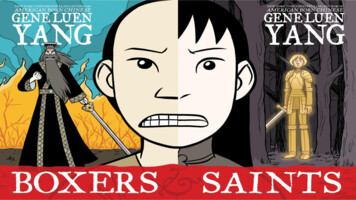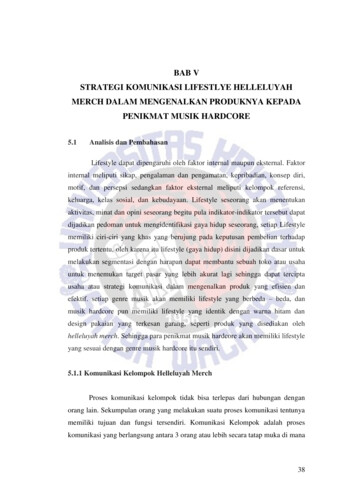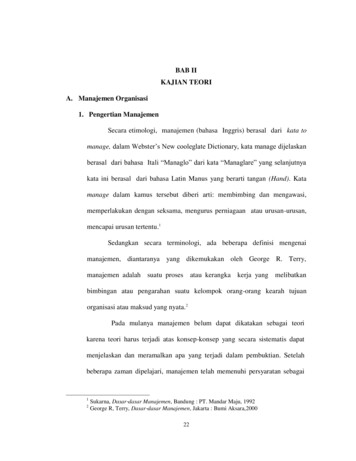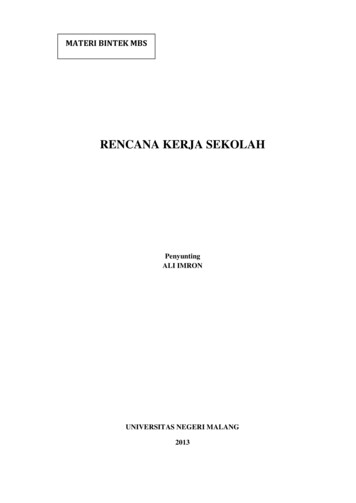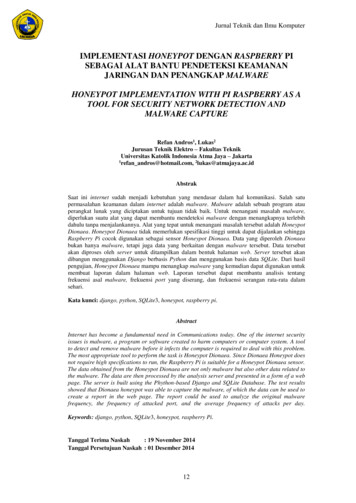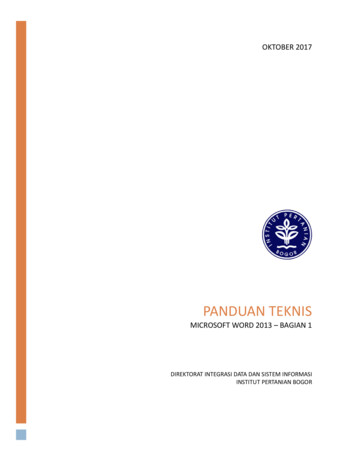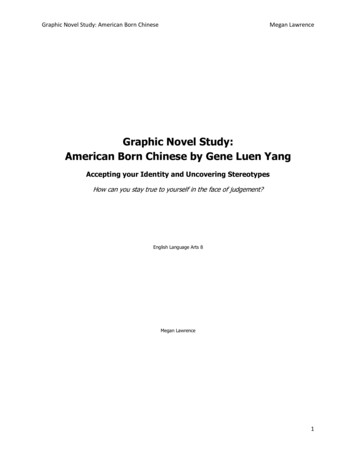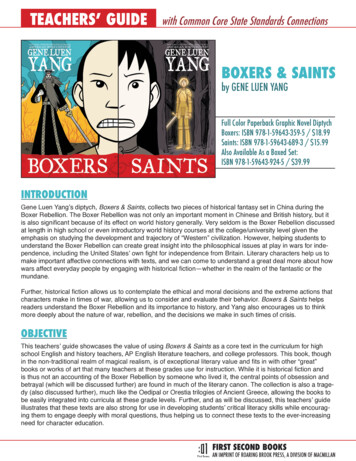
Transcription
TEACHERS’ GUIDEwith Common Core State Standards ConnectionsBoxers & Saintsby Gene Luen YangFull Color Paperback Graphic Novel DiptychBoxers: ISBN 978-1-59643-359-5 / 18.99Saints: ISBN 978-1-59643-689-3 / 15.99Also Available As a Boxed Set:ISBN 978-1-59643-924-5 / 39.99IntroductionGene Luen Yang’s diptych, Boxers & Saints, collects two pieces of historical fantasy set in China during theBoxer Rebellion. The Boxer Rebellion was not only an important moment in Chinese and British history, but itis also significant because of its effect on world history generally. Very seldom is the Boxer Rebellion discussedat length in high school or even introductory world history courses at the college/university level given theemphasis on studying the development and trajectory of “Western” civilization. However, helping students tounderstand the Boxer Rebellion can create great insight into the philosophical issues at play in wars for independence, including the United States’ own fight for independence from Britain. Literary characters help us tomake important affective connections with texts, and we can come to understand a great deal more about howwars affect everyday people by engaging with historical fiction—whether in the realm of the fantastic or themundane.Further, historical fiction allows us to contemplate the ethical and moral decisions and the extreme actions thatcharacters make in times of war, allowing us to consider and evaluate their behavior. Boxers & Saints helpsreaders understand the Boxer Rebellion and its importance to history, and Yang also encourages us to thinkmore deeply about the nature of war, rebellion, and the decisions we make in such times of crisis.ObjectiveThis teachers’ guide showcases the value of using Boxers & Saints as a core text in the curriculum for highschool English and history teachers, AP English literature teachers, and college professors. This book, thoughin the non-traditional realm of magical realism, is of exceptional literary value and fits in with other “great”books or works of art that many teachers at these grades use for instruction. While it is historical fiction andis thus not an accounting of the Boxer Rebellion by someone who lived it, the central points of obsession andbetrayal (which will be discussed further) are found in much of the literary canon. The collection is also a tragedy (also discussed further), much like the Oedipal or Orestia trilogies of Ancient Greece, allowing the books tobe easily integrated into curricula at these grade levels. Further, and as will be discussed, this teachers’ guideillustrates that these texts are also strong for use in developing students’ critical literacy skills while encouraging them to engage deeply with moral questions, thus helping us to connect these texts to the ever-increasingneed for character education.FIRST SECOND BOOKSAN IMPRINT OF ROARING BROOK PRESS, A DIVISION OF MACMILLAN
TEACHERS’ GUIDEBOXERS & SAINTS by GENE LUEN YANGAbout the BookBoxers & Saints keeps alive a tradition of literature that has been known to us for centuries: the tragedy.Boxers details the life of Lee Bao, a young man who is determined to rid his country of foreign influence.Saints concentrates on the life of Four-Girl/Vibiana, a character to whom we are introduced in Boxers and fromwhose viewpoint we see another side of the Boxer Rebellion. Four-Girl/Vibiana is not necessarily convincedthat the colonization and missionary work of the foreigners in China is the best thing for her country; but she isalso lonely and finds with the foreigners a community and even love. Through both protagonists’ eyes, readersare treated to stories about belief and love.About the AuthorGene Luen Yang is one of the most noted authors of graphic novels to come along since Art Spiegelman, andhis graphic novels are some of the most literary examples of the format available to teachers for use in theclassroom. He has written and illustrated the first graphic novel Printz winner, American Born Chinese, as wellas written The Eternal Smile (illustrated by Derek Kirk Kim) and Level Up (illlustrated by Thien Pham). He alsowrote and illustrated Animal Crackers (a collection of two earlier graphic novellas) and a kids graphic novel,Prime Baby. He is also currently working on a series of graphic novels that follow Ang and Team Avatar’s journey after the series finale of Avatar: The Last Airbender.Placement and Text Complexity(CCSS.ELA-Literacy.RL.11-12.10)Though they do not list graphic novels on the list of suggested texts, the Common Core State Standards dosuggest that graphic novels, like films, can be used to teach students narrative (or “stories,” according to theStandards), allowing teachers to advocate for graphic novel use in the high school English curriculum. Boxers& Saints is suggested for use with 11th-12th grade English classes, AP English Literature classes, and collegelevel introduction to literature classes. Because this text is a graphic novel, it may be difficult to determine textcomplexity, and it is suggested that you rely on qualitative elements of text complexity to determine placement.This book is mature in its scope, not because of the violence, but because of the deep philosophical questionsthat are asked by Yang through his text. These questions are not easy for many adults to wrestle with, and thelevel of sophistication about the complexity of morality in times of war, as well as the developmental readinessnecessary to discuss these issues, are not usually found among middle and junior high school students.Further, students should have familiarity with the Boxer Rebellion, which gives us a historical context for thestory told in Boxers & Saints, and many students are not exposed to enough world history to understand theissues that underlie the Boxer Rebellion and thus the text.As argued in the teachers’ guide, it is suggested that educators think about this text as a piece of tragic literature. Though freshmen and sophomores may be familiar with Romeo and Juliet, the form of tragedy itself isseldom studied until 11th or 12th grade when students can be expected to be familiar with some of the basicideas. These texts, with foci on obsession, betrayal, and justice, are excellent for pairing with other importanttragic pieces like Macbeth, Oedipus Rex, and Medea. Further still, when studying these texts as important hallmarks of the literary tradition, familiarity with texts like Frankenstein can help students to explore more deeplysome of the central ideas and themes of Boxers & Saints. It is highly suggested that students read BernardShaw’s Saint Joan as a paired text alongside Boxers & Saints to explore some common themes that Yangtouches on; however, Saint Joan is a work that also would seldom be taught under 11th grade, if found in highschool curricula at all.An ability to understand and discuss religion maturely also matters to a study of Boxers & Saints. While Boxers presents a set of characters who believe sincerely in the traditional Chinese gods, Saints presents a world2
TEACHERS’ GUIDEBOXERS & SAINTS by GENE LUEN YANGwhere the characters instead embrace the Christian religion. In these books, Christian beliefs exist alongsideChinese spirituality, and neither is shown to be superior.While the text is a graphic novel, and while it has violence, the sophistication of the work—like any piece ofliterature—is in the questions with which students must wrestle. They must consider the genuine and realcomplexities of war as they work to unravel and make sense of these texts, and they must come to understandwhy it is that belief and religion are so important to the individual without dismissing that belief as fanaticism.At the same time, the books also explicitly deal with the path a person can take to fanatacism and extremeism,depicting their consequences in a relatable, understandable way. It is essential that students look at the deepervalues at work in Yang’s text as they consider how to situate the work in a literary tradition.Focus on Obsession(CCSS.ELA-Literacy.RL.11-12.1-11-12.3; 11-12.9)Many great pieces of literature like Shelley’s Frankenstein, Goethe’s Sufferings of Young Werther, or Mellville’s Moby Dick focus on protagonists who are obsessed to the point of mania. In Boxers, Bao is obsessedwith cleansing his country of foreign invaders, seeking to establish a pure China. Because of experiences hehas with foreigners and traitors (Chinese natives who align themselves with foreigners), he invests his energyand life in learning how to combat this foreign contamination, and then wages a campaign against it. In Saints,Four-Girl/Vibiana’s Christian beliefs lead her to sacrifice her own life so as to maintain her faith. The point atwhich obsession turns to mania and fanaticism can lead students to lively and important discussions that encourage them to think about the role their beliefs play in determining their actions.Q:Why is it that we categorize certain actions based on beliefs as fanatical or manic while we see othersas more justifiable or pure?Focus on Justice(CCSS.ELA-Literacy.RL.11-12.1-11-12.6)Many classical tragedies deal with the role that divine justice plays in the lives of the protagonists. In Medea,for instance, Jason breaks an oath of loyalty to Medea and to suffers immensely for it. In Oedipus Rex, thetown is punished because Oedipus has defied the gods’ will. Even in Marlowe’s Dr. Faustus, Faustus’ unwillingness to repent allows an audience to feel that his inevitable suffering is justifiable. While each of these playsallows for catharsis—spiritual cleansing—our sense of catharsis also ties closely to our sense of justice. Wewalk away from tragedy feeling that the tragic end of characters was not only plausible but also the only way toachieve justice.In Boxers, Bao makes multiple promises throughout the text that allow him to gain the support of the spirits orgods of China, though none more strongly professed than his vow to save China at all costs. However, as thebook unfolds, he has to consider the value of each of the promises he has made and how they might be integral to his goal of saving the purity of China. He considers abandoning his oath to Ch’in Shih-huang/Qin ShiHuang while he simultaneously makes a promise to Mei-Wen, his love, that he will not destroy the library. Thelibrary, however, is an obstacle to fully ridding China of the foreign colonists and missionaries. Caught betweentwo oaths, he ends up burning the library, only for his militia to be ambushed and assassinated. As the spirits—both noble and deceitful—turn away from the dying mortals, he realizes that his actions were in error.Q:Was Little Bao’s (seeming) death at the end of Boxers the only way to achieve justice?Simultaneously, justice can be found when a character is “rewarded” in some way for maintaining his/herbeliefs. In Antigone, the close to the Oedipal cycle, Antigone’s defiance of Creon to follow the righteous lawof the gods ends in her imprisonment and suicide (though, like Medea, we can question if the female is thetragic hero or if it is not instead Creon, like Jason). Because she has died in defiance of the law of man thatcontradicts the laws of the gods, Antigone’s death is nobler and is a final step to show that Creon has defiedthe gods. In Saints, Four-Girl/Vibiana allows herself to be executed by Bao because she will not surrender her3
TEACHERS’ GUIDEBOXERS & SAINTS by GENE LUEN YANGloyalty to the Christian religion. Like Antigone, she has become a martyr to her cause. Readers may be upsetby her death; however, her death is justifiable as she dies to preserve her faith in her actions.While Bao executes Four-Girl/Vibiana, her death at his hands is more complicated than “right or wrong.” Baohas sworn an oath to rid China of the influence of the British and the Christian missionaries whom he feelshave defiled the land. He does not see Four-Girl as merely a traitor and does recognize her as a human being, offering her a chance to relinquish her faith before he must follow through on his oath. However, we arealso shown, earlier in Boxers, that Bao had a crush on Four-Girl/Vibiana as a child. Further, Bao stops SecondBrother from manhandling Four-Girl/Vibiana, illustrating that his desire to rid the country of foreign influenceis not uncivil. There is a code that the militia follows, and he will not allow that code to be violated. However,he believes that what he is doing is in the best interest of the country. Were Four-Girl/Vibiana to survive, shewould work as a missionary and bring others to her cause. We can see—and sympathize—with both characters, tragic because they both seek to maintain their beliefs. It is these nuances that illustrate how complicatedwar can be and how we can rarely ever find simple answers to questions of morality and justice.Q:We have a tendency to sympathize with people who feel strongly enough about their beliefs to die forthem. But in Boxers & Saints, both Little Bao and Vibiana die (or, in Little Bao’s case, seems to die).For whom do you feel most strongly for, and why?Saints subverts Bao’s “tragic story” by revealing that he didn’t tidily die for his cause/die for his crimes. Baoultimately can claim neither the role of tragic hero (martyr) or tragic villain (with a death justified by his infractions)—he survives, and, what’s worse, survives by betraying his own cause—and his oaths—utterly. Thetheme of oaths reoccurs when Little Bao’s brother cites their long-ago oath as he helps Bao escape and survive.Q:Why did one of Little Bao’s oaths survive, but not the others?Another area to concentrate your discussions of justice is in considering Father Bey. This secondary characteris an important catalyst in both Boxers and Saints, and he most represents the betrayal that Bao feels whenseeing Chinese people who have come to have Christian beliefs, lured away from their traditional religion bypeople like Father Bey. While he is a religious man, he has no respect for non-Christian beliefs. He desecratesand then destroys, in front of Bao, a figure of a local spirit as an idol that blasphemes Christian belief.Q:Does Bey’s willingness to insult the religion of others while trying to promote and convert others to hishis own religion may make his execution more justifiable than the death of Four-Girl/Vibiana or theseeming death of Little Bao? What justice is expressed in this death?Focus on Tragedy(CCSS.ELA-Literacy.RL.11-12.4-11-12.6)While the above section focuses on justice and its importance to tragedy, there are other tragic elements thatare evident in Boxers & Saints that help us to anchor this collection in the curriculum. First, because the text ispresented visually, we can teach it as if it were a stage production and not just a literary text to be read. Thereis much visual action throughout the text that can help students to appreciate the text’s complex nature.Boxers, when read alone, functions as a classical tragedy—the book ends with Little Bao’s death. However,upon reading Saints, you find that Boxers has two readings, as Little Bao is revealed to be alive at the conclusion of Saints. This elevates Boxers & Saints beyond a single story into a true diptych, where the second bookradically reframes the first one. In this section on tragedy, we’ll focus on reading Boxers without the influence ofSaints.Further still, three central elements to tragedy—hamartia (tragic flaw), peripeteia (epiphany), and anagnorisis(turning point)—are important for discussion with Boxers & Saints. (As a note, the use of irony is discussedunder critical literacy.) While both Bao and Four-Girl are peasants, unlike most characters in tragedy, perhaps4
TEACHERS’ GUIDEBOXERS & SAINTS by GENE LUEN YANGthis is an adjustment to modern sensibilities: the common man is a powerful figure in modern literature—and inmodern tragedy.Q:Discuss Bao’s and Four-Girl’s tragic flaws—what is it that makes each tragic according to the events inthe story? Are there moments where they have epiphanies and come to realize that they may need toadjust their actions or thoughts in light of new information? Are there turning points to their fortunes?Are there moments where they could act differently with a different outcome than that which isanticipated?Another key element of tragedy is the foil—that character against whom the protagonist’s most human qualitiesbecome evident. While reading Saints, we can ask students to consider foils against the protagonists. For instance, Father Bey serves as a foil to Four-Girl and we can ask students to detail how his personality is distinctfrom Four-Girl’s/Vibiana’s personality. Even though they are both religious, students may note that Father Beyis more extreme in his views than Four-Girl. You can also compare Bao to Second Brother while reading bothBoxers and Saints, helping students to see Bao’s approach to revolution as more purposeful than SecondBrother’s as the latter approaches the situation more chaotically. Of course, you can also compare Four-Girlagainst Saint Joan, especially if your students have additional knowledge about Saint Joan’s history and familylife. Further, there are moments in Saints where we see Four-Girl/Vibiana wrestle with her faith against hercultural traditions, especially the scene involving orphans (p. 218-219).Q:Who is the foil for Little Bao? For Vibiana?Resurrection, in Boxers & Saints, is associated with Christian mythology. Ironically, of the two central characters, Bao is the one who experiences something like a resurrection, not Vibiana—though the text in Saintshints subtly at an afterlife of some sort for her.Q:Q:How does Bao’s resurrection at the end of Saints change his story? Can his story still be a tragedy?What would change about Vibiana’s story if she had also escaped death?Focus on What’s in a Name(CCSS.ELA-Literacy.RL.11-12.1-11-12.4)Yang names Saints protagonist Four-Girl because she is the fourth daughter and her family cannot be bothered to even give her a name. While she tries to show herself to have value, her family is quick to dismiss her,and Four-Girl finds community, worth, and a name in the Catholic faith. The protagonist of Boxers, Bao, on theother hand, is given a name that means treasure. Many adolescents are fascinated with the meaning of theirown names and how that might relate to their destinies.Q:How are these names important to the roles each character plays in the text?In allegorical drama, specifically the highly religious Medieval morality plays, characters were given names toconnect them to the population as a whole, or to the ideas related to faith or the context of the society in whichthe plays were produced. We can encourage students to explore both Four-Girl and Bao as allegorical characters who represent the struggles of humanity in the face of war. While reducing the collection to an allegory—there is much power in seeing it rather as historical fantasy (see below)—can reduce the overall power of thetexts, it may be helpful for students to explore the characters as representing people in any number of contextsof war.Q:If Little Bao and Four-Girl are allegorical characters who represent the struggles of humanity, what doeach of them represent? And how do their names play into this representation?Further, Bao is strongly attracted to Four-Girl during their initial encounter, amazed by the way her face resembles an opera mask. Not knowing who she is, Bao initially gives her a name based on her face. While we needto be cautious about the potential for exoticizing the role women play in Chinese culture, the lack of love thatFour-Girl has in her life is certainly evident in her expression, and this may be part of why Bao is attracted toher when he first sees her.5
TEACHERS’ GUIDEQ:BOXERS & SAINTS by GENE LUEN YANGExplore Chinese opera masks, and Ancient Greek masks used for drama (which relate to the idea oftragedy again), in terms of Four-Girl’s existence as a tragic heroine.Four-Girl is also given a Christian name that she accepts, the name Vibiana.Q:Q:Research the name Vibiana. Is it an appropriate name for the character?Consider whether Bao’s name is appropriate to his character based on his actions.Focus on ISOLATION and Love(CCSS.ELA-Literacy.RL.11-12.1-11-12.3; 11-12.5-11-12.6)Bao’s initial actions are driven mostly by love—not only his love for China, but also for his father, his mentors,and his fellow countrymen. Much of Four-Girl’s life is about trying to find love. In Boxers & Saints, the protagonists are confronted by death—a moment of life illustrated by whether you stand alone when you die and theinvestment you place in love.In Boxers, whenever a militia member dies, the spirit occupying his or her body leaves. Earlier in Boxers, Baois about to die when he is pulled back by the spirit Ch’in Shih-Huang/Qin Shi Huang who makes him swear torid China of foreign defilers. However, Bao also falls in love with Mei-Wen, and his love makes him also promise to protect China, not just rid the country of the foreigners. But he abandons his oath to Mei-Wen to protectChina (by not destroying its history and knowledge), and their love is broken. She leaves him, unknowingly, toface an ambush. His loneliness is compounded by the image of the spirits abandoning the militia after the ambush, and we know (based on information that will come in Saints) that their bodies will be burned and neverreturned to their families.Q:What do you feel is more important, love for another person, or love for your country? Do you feeldifferently about this at the end of Boxers than you did at the end of Saints?In Saints, we see that Four-Girl spends most of her life alone, seeking community and love, and she sees parallels between herself and Saint Joan. However, when Four-Girl prepares to die, she has a vision of Saint Joanon the pyre and then a vision of Jesus, telling her to think of others. At the end of her life, she has found lovebecause she has been true to herself in ways that Bao could not be. Bao was given the name of treasure, andher name was a non-name. In the end, though, she earns and embraces a name she gains through her faith,and she learns that her savior loves her.Q:Just as Saint Joan was seen as a fanatic for her beliefs, what is the degree to which Vibiana’s beliefsare faith, obsession, or fanaticism? What about Little Bao’s?The text illustrates that both Bao and Four-Girl/Vibiana have the potential for love. Bao abandons his love tofulfill his promise to his god while Four-Girl/Vibiana embraces her love and surrenders her life.Focus on Character Evolution(CCSS.ELA-Literacy.RL.11-12.1-11-12.3; 11-12.5)Students can keep track of how characters evolve through the texts. Unlike traditional tragic texts, we get tosee the characters age, and we see the outcomes of particular decisions that the characters make at variouspoints in their lives. There is certainly a sense of fatalism to the texts—the characters must make the decisionsthey make because the text is rooted in real historical events. However, Yang also allows us to see that thecharacters may have some element of free will. Students should be encouraged to think about how the situation of war might limit the decisions that we make as human beings.Q:Do we act differently than we might normally when we are confronted with the loss of that in whichwe believe? Ask students to keep a character chart in which they trace the protagonists’ lives, thedecisions they make, and how these decisions are influenced by the context of war.6
TEACHERS’ GUIDEBOXERS & SAINTS by GENE LUEN YANGFocus on Critical Literacy(CCSS.ELA-Literacy.RL.11-12.1-11-12.7)A central element of critical literacy is considering multiple points-of-view and perspectives about a particularsituation. Historical fiction, the genre to which Boxers & Saints belongs (as well as magical realism/fantasy),places fictional characters in the context of major historical events, helping readers to understand the humanexperience. Literature is different from historical treatise in that historical fiction a) often focuses on the common man and b) focuses on how historical moments interact with our natures as human beings. While manypieces of historical fiction offer the reader an understanding of wars or revolutions, Yang presents two perspectives—that of Lee Bao and Four-Girl/Vibiana. By doing so, Yang allows us to see the historical moment evenmore complexly through the eyes of two human beings whose lives are effected by conflict. While there areeven more perspectives or points-of-view that can be expanded upon through activities like fan-fiction, Yangillustrates how perhaps the most central elements of human experience—love and belief—are handled in timesof war. Further, Boxers and Saints’ protagonists are male and female respectively, allowing us to not privilegeone particular gendered way of seeing in the classroom.Q:What are some other perspectives through which you could see the Boxer Rebellion? Name threeoptions, and describe briefly what historical people might embody these perspectives.Critical literacy also suggests that we ask students to think about whose information they trust, how that information may be biased, and how they can look for biases in information. We also look for privilege that isevident in the information that is presented, looking to see how people are positioned in relation to each otherin each discourse moment. In Boxers, Bao implicitly trusts the spirit of the emperor Ch’in Shih-huang/Qin ShiHuang, whom he does not initially recognize and with whom he becomes fascinated. Even when Ch’in Shihhuang/Qin Shi Huang reveals his own identity and provides the backstory of his rise to Emperor—deceit, murder—Bao trusts him because of his role as both spirit and emperor. It may help that he appears in the contextof other spirits whom Bao knows to be honorable. Chinese folklore, of course, allows for spirits to be deceitfulin ways that the mythology of Christianity does not; however, Bao believes that Huang’s role as emperor inbuilding the Great Wall complements his own desires to rid the country of foreign defilers who taint China andits culture.Huang’s aggressive mannerisms and tone eventually cause Bao to rethink his allegiance with him; however healso knows that he has sworn an oath to make China pure, and fears retaliation from Huang. The other spirits appear to nobly help the militia, not expecting anything in return for their assistance, and yet Bao does notquestion Huang’s missives, accepting them to be truths for ridding the country of the British colonialists andmissionaries. Uneducated, Bao does not understand Huang’s history of brutality; even though he had helped tosecure the boundaries of China and to repel foreign invaders, Huang was also exceptionally concerned abouthis ultimate authority. He destroyed access to knowledge—burning books, libraries, and even assassinatingscholars—before dying. His own legacy was of course questionable; however, Bao blindly obeys his spirit,showing the blind obedience the living Huang would have expected of his people.The burning of the library that ends up being an ambush for the militia is significant because it is clear thatHuang has misled Bao all along. As Mei-Wen questions Bao about whether he should burn the library (because doing so would be akin to destroying China,) Bao does not understand the significance of his undertaking. Western students may not be aware that many religions allow for spirits to be deceitful or tricksters. Theymay understand the idea of the Devil’s silver tongue, but at the same time, Huang is not the embodiment of evillike the Devil. As such, students are left to make their own choices about whether Huang is acting in the bestinterest of the country rather than for his own purposes.Q:When was the point that you stopped believing that Huang was a positive spirit? What actions indicatedhis self-interest?That emperors (and leaders generally) should take care of the interests of their people may also be a belief ofmany students. They may not believe that leaders would be self-interested, although by 11th or 12th grade,7
TEACHERS’ GUIDEBOXERS & SAINTS by GENE LUEN YANGthey may have been exposed to enough historical and literary figures or modern politics to begin questioningthis assumption. However, Huang clearly represents a more totalitarian government where it is his beliefs thatdecide the will of the people. Huang really thinks his merciless, library-burning, scholar-burying mode of rulership is the right way to preserve China’s greatness, and in Boxers he’s urging Bao to follow in his footsteps.The end goal, for him, is still China’s greatness. Mei-Wen presents a more egalitarian, cooperative model ofpatriotism.In Boxers, Bao clearly acts with what he believes is the best interests of China and the people in mind. Thiscould lead students to believe that because Bao trusts Huang he must be trustworthy. However, Yang providesmany moments of irony where the trust that Bao places in Huang may be worth reconsideration. Further, wesee the irony of Bao’s trust if we have extratextual knowledge of who Huang was in history and why burningthe library might not be in the country’s best interests.Q:Q:Q:What form of government would you choose, Huang’s or Mei-Wen’s? Why? Would your answer still bethe same if you were living back in the 1900s?Why might Bao trust Huang and his help, even after questioning his allegiance? Find three reasons—with textual evidence—why Bao might believe Huang.Think critically about the violence in the text. When is it that violence seems justified, and when is itgratuitous? When is one group seen as more extreme or violent than another? Do our perceptions ofviolence vary depending on the perspective from which they are presented to us?Focus on Semiotics: What is China? And the Complexities of War(CCSS.ELA-Literacy.RL.11-12.1-11-1
classroom. He has written and illustrated the first graphic novel Printz winner, American Born Chinese, as well as written The Eternal Smile (illustrated by Derek Kirk Kim) and Level Up (illlustrated by Thien Pham). He also wrote and illustrated Animal Crackers (a collection of two earlier g
